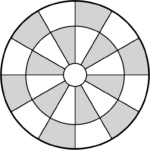Click here [1] for the Problem Extension Worksheet version of the Problems of the Week.
Click here [2] for an MS Word version of the Problems of the Week.
Click here [3] for the Canadian Problem Extension Worksheet version of the Problems of the Week.
Click here [4] for a Canadian MS Word version of the Problems of the Week.
 [5]Lower Elementary:
[5]Lower Elementary:
Question: A protocol droid and a utility droid are both trying to reach an escape pod so that they can get away from an evil imperial spacecraft. The protocol droid walks at a speed of 2 mph. The utility droid rolls at a speed of 5 mph. If they start from the same place, then which one will reach the escape pod first? How can you tell?
Answer: the utility droid
Solution: The faster droid will reach the escape pod first. Since 5 is more than 2, we can tell that 5 mph is faster than 2 mph. So, since the utility droid rolls at a speed of 5 mph, it will reach the escape pod first.
 [6]Upper Elementary:
[6]Upper Elementary:
Question: Dejarik is a game played on a circular board. The game is for 2 players, and each player starts the game with 4 game pieces on the board. Each game piece takes up a single space on the board, which has 25 spaces in total. What percentage of the spaces are occupied if both players have all their game pieces in play?
Answer: 32%
Solution: If each player has 4 pieces on the board, then there are 4 × 2 = 8 pieces on the board in total. Since there are 25 spaces on the board, 8/25 of the spaces are occupied. We can turn the fraction into a percent by multiplying both the numerator and denominator by 4, since percentages are out of 100: 8/25 × 4/4 = 32/100 = 32%.
 [7]Middle School:
[7]Middle School:
Question: A smuggler’s starship navigates a shortcut through space to make the Kessel Run in 12 parsecs. The usual Kessel Run smuggling route is 18 parsecs. If a parsec is 3.26 light-years and a light-year is 5.88 trillion miles, then by how many trillions of miles does the smuggler shorten the Kessel Run? Round your answer to the nearest trillion miles.
Answer: 115 trillion miles
Solution: Since the usual Kessel Run smuggling route is 18 parsecs and the smuggler’s starship makes it in 12 parsecs, the smuggler shortens the Kessel Run by 18 – 12 = 6 parsecs. Next, we convert 6 parsecs to trillions of miles by multiplying by the conversion rates: 6 parsecs × 3.26 light-years per parsec × 5.88 trillion miles per light year ≈ 115 trillion miles.
 [8]Algebra and Up:
[8]Algebra and Up:
Question: A space knight swings her laser sword in a full circle around her body. The laser sword’s energy blade is 3 feet in length. The space knight holds the laser sword so that the blade emits from the hilt 4 feet from the center of the circle. Find the area in which the laser sword’s blade slices through the air.
Answer: 33π square feet
Solution: To find the area in which the blade slices through the air, we find the area of a circle whose radius is 3 + 4 = 7 feet, then subtract the area of a circle whose radius is 4 feet for the space inside the circle where the laser sword’s blade doesn’t touch. The area of the full circle is πr2 = π(7)2 = 49π, and the area of the circle inside is π(4)2 = 16π, so the area inside is 49π – 16π = 33π square feet.
1 Comment To "Problems of the Week – August 27 to August 31"
#1 Comment By Tyler Casebolt On August 27, 2018 @ 1:47 pm
I love the questions this week! They’re even true to the source material!